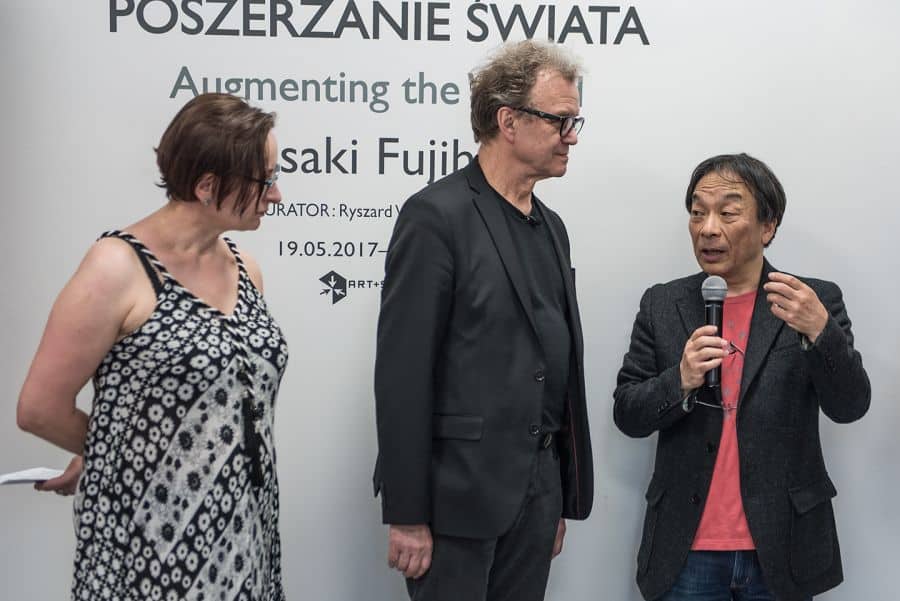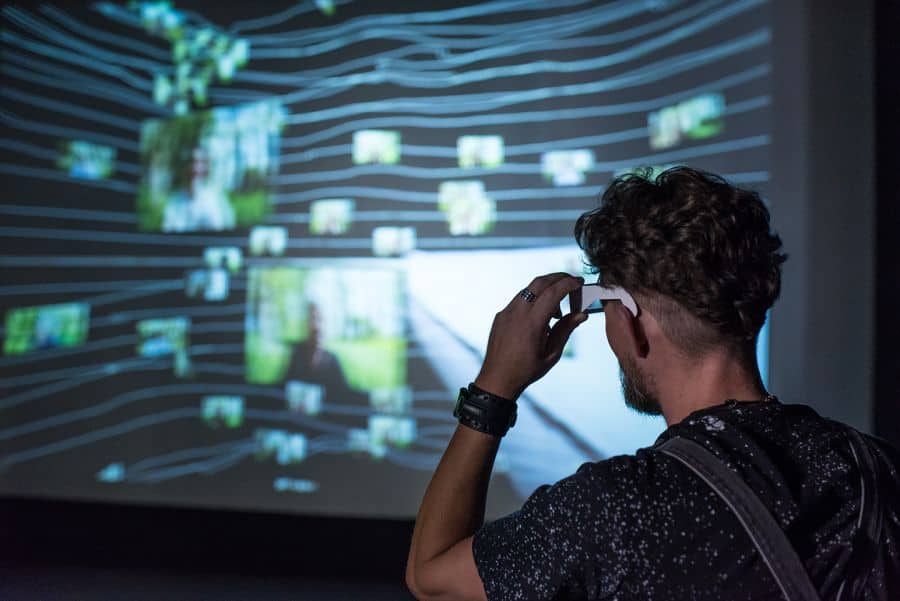Sylwia Krasoń: The exhibition entitled Augmenting the World, which presents works by Masaki Fujihata, is a part of the “Art+Science Meeting”. This large-scale project, for which you play the role of artistic director, was initiated in 2011 by the LAZNIA Centre for Contemporary Art in Gdańsk. The “Art+Science Meeting” is an interdisciplinary event with an extensive programme which includes, among other things, exhibitions, debates and various workshops. It is aimed at exploring the relationship between art and science by offering a space for interaction between representatives of these two worlds. How did the idea for such an event originate?
Ryszard W. Kluszczyński: The idea was a result of my research and analysis of the condition of art nowadays, which has been at the centre of my interests for a long time. Currently, art is created and presented in a transdisciplinary environment. It develops most quickly and efficiently when it is exposed to other activities which societies engage in. The development of art is hindered when art remains secluded and preoccupied exclusively with matters inherent to it. I noticed that the tendencies in new media art, which developed in the most exciting and dynamic way in the 1990s, are nowadays, i.e. in post-media context, to engage in a productive dialogue with the world of science, thereby going beyond the traditional borders of art. One of the reasons for this is that numerous new media artworks were closely related to scientific research.
This fact was noted and classified as a basic feature of this kind of art because we have adopted a different perspective while familiarising ourselves with works by new media artists. A good example here would be the artists Christa Sommerer and Laurent Mignonneau, whose works I presented at exhibitions held as early as in the 1990s. Another example is that of Monika Fleischmann and Wolfgang Strauss. The very first time I presented this complex issue as a curator was during the 2010 Mediations Biennale in Poznań. This was where I showed works by artists who created in the spirit of art and science united, artists like Eduardo Kac, Zbigniew Oksiuta, and Paul Vanouse. At the same time Jadwiga Charzyńska, the director of the LAZNIA Centre for Contemporary Art expressed her interest in the idea of a long-term programme to be organised in Gdańsk. She asked me to create such a programme and that was where I first put forward the idea of the “Art+Science Meeting”.

Augmenting the World, Masaki Fujihata, LAZNIA Centre
SK: Masaki Fujihata is one of the most prominent and influential artists who use new media technologies in their artistic activities. He is also considered one of the pioneers of interactive art. As members of the audience and, generally speaking, as people for whom art is being created, what can we learn about the contemporary world from Fujihata? What can we expect from the Augmenting the World exhibition?
RWK: Augmenting the World is not only about exploring the works of Masaki Fujihata, but also about introducing the viewer to contemporary reality. Augmented reality is where we live and function, using various media technologies and combining different spheres of reality through our experiments with new media. Mobile and virtual network technologies are our inseparable companions. They create hybrid environments and allow us to directly experience the dimensions and elements of reality which are not strictly tangible to us. Such ‘inaccessible’ realities are being presented in video games more and more often. Art showcase the results of such experiments with aesthetic means. In other words, it proposes a different approach to the same technology. The exhibition of Fujihata’s works helps us understand how living in such a world influences our models of perception, our experiences and identities which are based on empirical knowledge. It also explains to us how social relations develop given all the above.

Augmenting the World, Masaki Fujihata, LAZNIA Centre
SK: The exhibition title, Augmenting the World, refers to augmented reality (AR), which blends computer-generated pictures with reality. Augmented reality is just one of numerous topics which are of interest to Fujihata. Why have you chosen this title and, thereby, emphasised this specific aspect of Fujihata’s artistic activity? Why is this element of his activity particularly intriguing?
RWK: Augmented reality has become the most important aspect of Fujihata’s current work. This is exactly what I had in mind when I decided to organise an exhibition where the aim was to make Fujihata’s art familiar to a Polish audience. Presenting this aspect was also particularly relevant because the artist’s latest works and ongoing projects are significantly concerned with augmented reality. Nevertheless, Fujihata is also truly interested in mobility, as well as network technologies and global positioning (GPS). He uses these technologies to create complex and diverse realities of his works. Moreover, other vital aspects of Fujihata’s activity can be seen in his augmented reality artworks. Here we can mention the morphology of visual perception, multimodality and multisensory, as well as interactive means of expression. They have been present in Fujihata’s works for a long time; however, the evolution of new means and technologies ensured that those aspects manifested themselves in different ways.
To sum up, by emphasising augmented reality in Fujihata’s works, I prompted the audience to explore other aspects of the artist’s works as well. I also wanted to direct our visitors’ attention to the interconnectedness of all these aspects and their relevance for the works Fujihata creates.

Augmenting the World, Masaki Fujihata, LAZNIA Centre
SK: Fujihata used augmented reality in his works as early as in the 1990s. What was this technique about then, and how was it different to the augmented reality of today? Is the evolution of Fujihata’s work more about the evolution of the form and areas of implementation of new technologies or is it a result of him exploring new meanings and topics?
RWK: In the 1990s, augmenting the world through Fujihata’s works was possible by using single technologies and confronting them with the real, material world. An example of this approach is the interactive installation “Beyond Pages”, which is also being presented at my exhibition. In this installation, Fujihata uses digital images and projects them onto material surfaces. Thanks to their interactive nature, these images can be experienced as a means, which enriches our tangible reality with something from beyond. In this way, they convert our common reality into augmented reality. Nowadays, Fujihata not only confronts reality with the virtual world, but he also juxtaposes various spheres of the virtual reality, which blend and transform into one another, thereby creating more space for experimenting. In fact, the evolution of Fujihata’s work combines the transformation of structures and technologies, and new topics introduced by the artist himself.

Augmenting the World, Masaki Fujihata, LAZNIA Centre for Contemporary Art in Gdańsk
SK: Tell us something more about you process of selecting works to be presented, and how you worked on their arrangement. As a curator, what was it like to collaborate with Fujihata?
RWK: We started to work on this exhibition in September, during a meeting at the Ars Electronica festival in Linz, Austria. There we had our initial conversation about our intentions and existing possibilities. Afterwards, our work on it gained quick momentum, which was quite unusual, because such endeavours are more time-consuming by their very nature. The circumstances were favourable for us. Therefore we worked very quickly. Our second meeting took place in November in Gdańsk. This time we had the opportunity to arrange the project we had developed within a defined setting, i.e. the space where we planned to exhibit the works. The arrangement was only virtual at the time, but it brought the project to life.
Fujihata himself wanted us to present only his latest projects. However, I proposed that we should also show his earlier works, so that we could present how the latest projects were influenced by the earlier ones, a proposal, thankfully, he happily accepted. As a result, the exhibition encompasses his works from the 1990s, i.e. Impressing Velocity (1992-94) and Beyond Pages (1995-97), as well as the latest ones – Voices of Aliveness (2012) and Capture in Half (2016). Fujihata additionally had a very interesting idea which enriched our exhibition; namely, that he wanted his work from 2003, entitled Field_Work@Alsace to be presented in a new AR format. Thanks to this, the exhibition presents a very wide spectrum of technological and aesthetic solutions.
The exhibition explores how the development of digital technologies influences art and culture. It provides the audience with an opportunity to multimodally experience transgression and explore the developing worlds, as well as immerse themselves in a fluid and hybrid reality.

Augmenting the World, Masaki Fujihata, LAZNIA Centre for Contemporary Art in Gdańsk
Masaki Fujihata, Augmenting the World
LAZNIA Centre for Contemporary Art in Gdańsk
Exhibition is open from 19 May 2017 to 2 July 2017
Curator: Ryszard W. Kluszczyński






